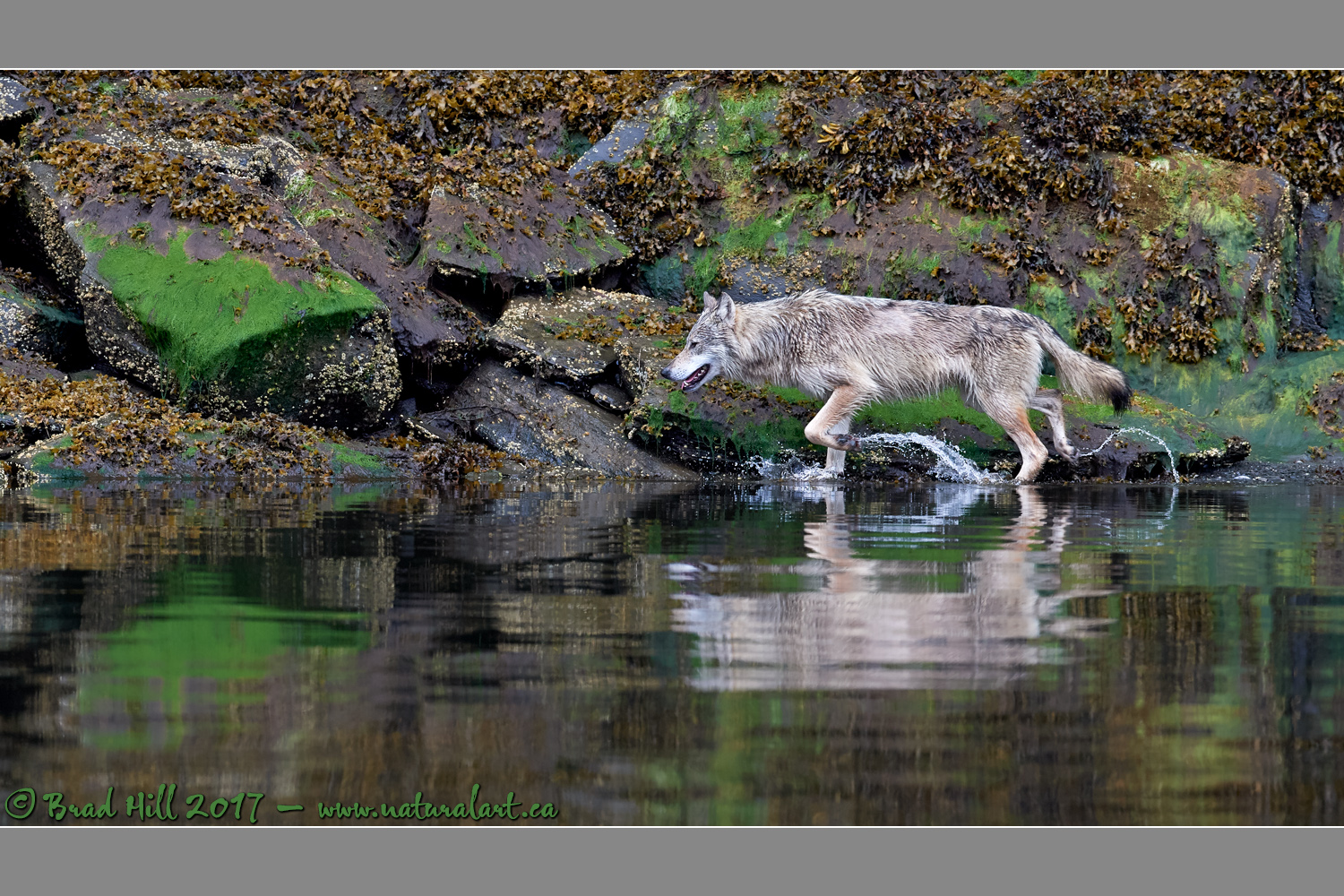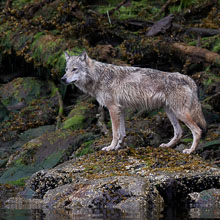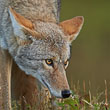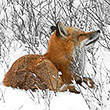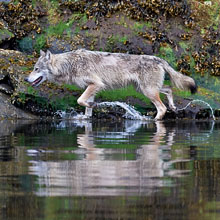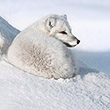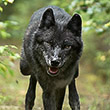Availability: Undetermined - Enquiries?
In the Field
Water Trails. Khutzeymateen Inlet, Great Bear Rainforest, BC, Canada. June 1, 2017.
I captured this image of a coastal Gray Wolf as it made its way along the long and sinewy Khutzeymateen Inlet on the northern BC coast. The wolf was clearly "on a mission" and wasted little time as worked its way over about 4 km of the shoreline while we watched it over about a 40 minute period. Over that time the wolf alternated between using forest trails along the edge of the inlet, rocky beaches and - at times - even trotting in shallow water (as seen here). The wolf appeared to have a very clear destination in mind and, based on how fast it traveled over the rough terrain, it was obvious it knew the area very well.
With this shot I got a little lucky. I was shooting a 500mm lens at the time and we were in a moving Zodiac so, by necessity, I was shooting fully hand-held. Because of the movement of the wolf and the motion of the "platform" I was shooting from (and because I was hand-holding a super-telephoto lens) I bumped the shutter speed up a little higher than I do when shooting static wildlife (even when hand-holding big lenses). That higher shutter speed coincidentally allowed me to "freeze" the water trailing from the wolf's paws - and I especially like how the water trail behind the wolf's hind paw was rendered by the 1/1250s shutter speed. Cool, eh?
One of the things I found so amazing about this unexpected encounter was how our presence seemed to have virtually no impact on the behavior of the wolf - it just kept on its merry way with only a few sideways glances at us. In BC this is incredibly rare - wolves have been persecuted and abused in BC for many, many wolf generations and consequently have become exceptionally wary and fearful of humans.
Sadly, the official policy of wolf abuse continues through to today, with the BC government treating them (through their wildlife management policies, hunting regulations, and a current active aerial gunning campaign) as vermin. In fact, this photograph was taken in the Skeena wildlife management unit (unit 6-14) and ANY hunter could shoot this wolf any time between August 1-June 15 (i.e., the wolf killing season is closed for only 6 weeks per year). And he/she could do so without a species-specific wolf hunting "tag". That same hunter could shoot up to 3 wolves during that calendar year. This means that a GROUP of hunters encountering a pack of wolves could blast away until all that's left is a pile of mangled, bloodied, and smoking carcasses. The "tag-not-required" hunting regulation encourages ANY BC hunter to opportunistically shoot any and all wolves they encounter. And yet virtually all scientific literature on the subject regards the wolf (and other apex predators) as absolutely critical to maintaining biodiversity and structuring ecosystems. The complete disconnect between wildlife science and wildlife management reaches its zenith in BC's Wolf Management Plan and associated policies.
Read more about what YOU can do to pressure the BC government to change its outdated and morally reprehensible approach to wolf management right here.
Here's a larger (2400 pixel) version of this beautiful coastal gray wolf for your perusal:
• Water Trails: Download 2400 pixel image (JPEG: 8.3 MB)
ADDITIONAL NOTES:
1. This image was captured during one of my "Grizzlies of the Khutzeymateen" photo tour in the spring of 2017. Each year I offer trips into two different parts of the Great Bear Rainforest as well as one to photograph aquatic mammals and oceanscapes near the northern tip of Vancouver Island. And, in selected years, I also offer photo tours to locations to capture other highly sought-after subjects, such as various boreal owl species and wildlife of Canada's Arctic. Details about these trips can be found on the Photo Tours page of this website.
2. This image - in all resolutions - is protected by copyright. I'm fine with personal uses of them (including use as desktop backgrounds or screensavers on your own computer), but unauthorized commercial use of the image is prohibited by law. Thanks in advance for respecting my copyright!
3. Like all wildlife photographs on this website, this image was captured following the strict ethical guidelines described in The Wildlife FIRST! Principles of Photographer Conduct. I encourage all wildlife photographers to always put the welfare of their subjects above the value of their photographs.
Behind the Camera
Water Trails. Khutzeymateen Inlet, Great Bear Rainforest, BC, Canada. June 1, 2017.
Digital Capture; Compressed RAW (NEF) 14-bit format; ISO 1800.
Nikon D5 paired with Sigma 500mm f4 Sport lens. Hand-held from floating Zodiac. OS on and in "OS1" mode, with OS1 stabilization customized to Moderate View mode; AF customized to Fast Priority AF.
1/1250s @ f6.3; -0.67 stop compensation from "recommended" matrix-metered exposure setting.
At the Computer
Water Trails. Khutzeymateen Inlet, Great Bear Rainforest, BC, Canada. June 1, 2017.
RAW Conversion to 16-bit TIFF using Phase One's Capture One Pro 10. Two raw variants (different versions of a single raw capture) processed, with the variants differing in exposure settings (0.2 stop total difference between the variants) and noise reduction settings.
Further digital corrections on resulting 16-bit TIFF files using Adobe's Photoshop CC 2017 and Light Crafts Lightzone. Photoshop adjustments included compositing (blending) of the two output files from the raw converter, minor colour desaturation to background greens, very minor exposure tweaks, and final selective sharpening for web output. Final tone-tweaking performed using LightZone's "tonemapper" tool.
Conservation
Water Trails. Khutzeymateen Inlet, Great Bear Rainforest, BC, Canada. June 1, 2017.
Ten percent of the revenue generated by this image will be donated to Raincoast*.
Species Status in Canada**: Only Eastern Wolf listed as species of "Special Concern" in May, 2001. Other populations not listed as Endangered or Threatened.
Species Status in the United States: Western Great Lakes population removed from list of Endangered and Threatened species on January 29, 2007. Proposed delisting of Northern Rockies population on January 29, 2007. Both actions are a direct result of a successful recovery plan. Congratulations! Wolves in other areas of the lower 48 states (including the Southwest wolf population), remain on Endangered Species list.
Probably no species alive today has suffered as much direct persecution from humans as has the Gray Wolf (Canis lupus). Once extremely widespread in North America, the Gray Wolf was virtually extirpated from the contiguous 48 states of America and now is regularly found within only a fraction of its historical range in Canada. While the Gray Wolf is currently listed as endangered in most of the 48 lower states of the United States and enjoys the privileges associated with such status (if lack of persecution and abuse can be thought of as a privilege), it is still official policy in much of Canada to rid the countryside of this magnificent keystone predator. As an example, in British Columbia, there is NO closed season on the wolf in most hunting jurisdictions and opportunistic slaughter is encouraged by policy (it is the ONLY fur-bearing species for which NO hunting license is required in British Columbia!). Conservation of wolves presents a puzzling paradox. Reduced to the most basic principles, wolf conservation is simplistic: we need only to stop persecuting this species in order for it to survive. Yet accomplishing this invariably proves incredibly difficult - it's as though wolf persecution has been institutionalized directly into government (and societal) bureaucracy.
*The Raincoast Conservation Society (and Foundation) is an effective and efficient organization that has been fighting for protection of this unique habitat. If you are looking for a meaningful way to contribute to the conservation of this amazing ecosystem, Raincoast will provide maximal "bang" for your conservation dollars.
**as determined by COSEWIC: The Committee on the Status of Endangered Wildlife in Canada












